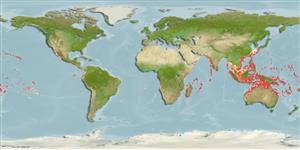>
Tetraodontiformes (Puffers and filefishes) >
Monacanthidae (Filefishes)
Etymology: Cantherhines: Greek, kanthos = the outer or inner corner of the eye, where the lids meet, 1646 + Greek, rhinos = nose (Ref. 45335).
Environment: milieu / climate zone / depth range / distribution range
Ökologie
seewasser riff-verbunden; standorttreu; tiefenbereich 0 - 70 m (Ref. 89467), usually 6 - 35 m (Ref. 9710). Tropical; 32°N - 32°S
Indo-Pacific: East Africa to French Polynesia, north to Japan and Hawaii. Eastern Pacific: Mexico to Colombia (Ref. 9318).
Size / Gewicht / Alter
Maturity: Lm ? range ? - ? cm
Max length : 38.0 cm TL Männchen/unbestimmt; (Ref. 30573); common length : 25.0 cm TL Männchen/unbestimmt; (Ref. 30573)
Rückenflossenstacheln (insgesamt): 2; Rückenflossenweichstrahlen (insgesamt): 34-39; Afterflossenstacheln 0; Afterflossenweichstrahlen: 28 - 35. Greyish brown to yellowish brown with about 12 vertical dark brown bars; lips whitish; male adults with orange peduncle spines; soft dorsal, anal and pectoral fins pale yellowish; caudal fin orange with dusky rays (Ref. 4421). Sexually dimorphic with males having longer and deeper orange peduncular spines and deeper orange tail and eyes (Ref. 37816).
Inhabit offshore coral reefs usually solitary or in pairs (Ref. 5503, 48637). Common in surface waters around oceanic islands (Ref. 9318). Benthopelagic (Ref. 58302). Shy species, usually retreating quickly into caves or large crevices of the reef (Ref. 48637). Juveniles are pelagic, seen under floating objects (Ref. 9318). Feed on tips of branching corals, algae, sponges, sea urchins, and mollusks (Ref. 1602). Minimum depth reported taken from Ref. 128797.
Life cycle and mating behavior
Geschlechtsreife | Fortpflanzung | Ablaichen | Eier | Fecundity | Larven
Myers, R.F., 1991. Micronesian reef fishes. Second Ed. Coral Graphics, Barrigada, Guam. 298 p. (Ref. 1602)
IUCN Rote Liste Status (Ref. 130435)
Warning: mysqli::__construct(): (HY000/1040): Too many connections in /var/www/html/includes/func_getlabel.php on line 46
Can't connect to MySQL database (fbapp). Errorcode: Too many connections
